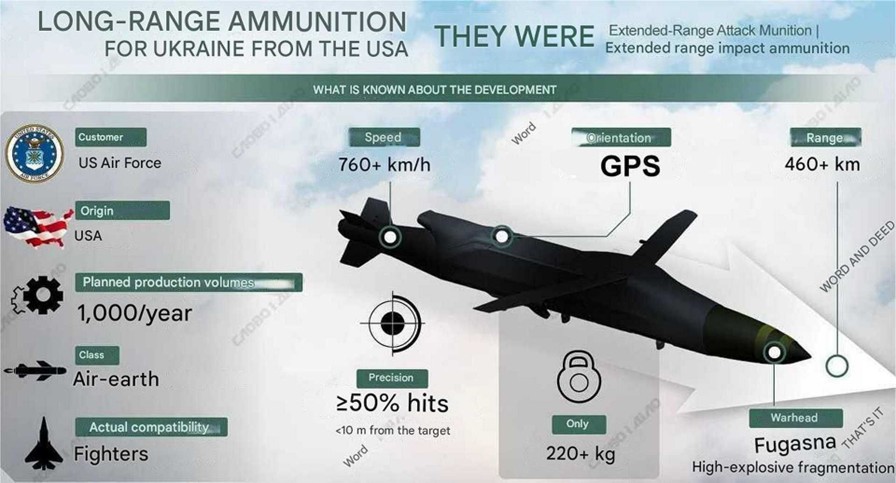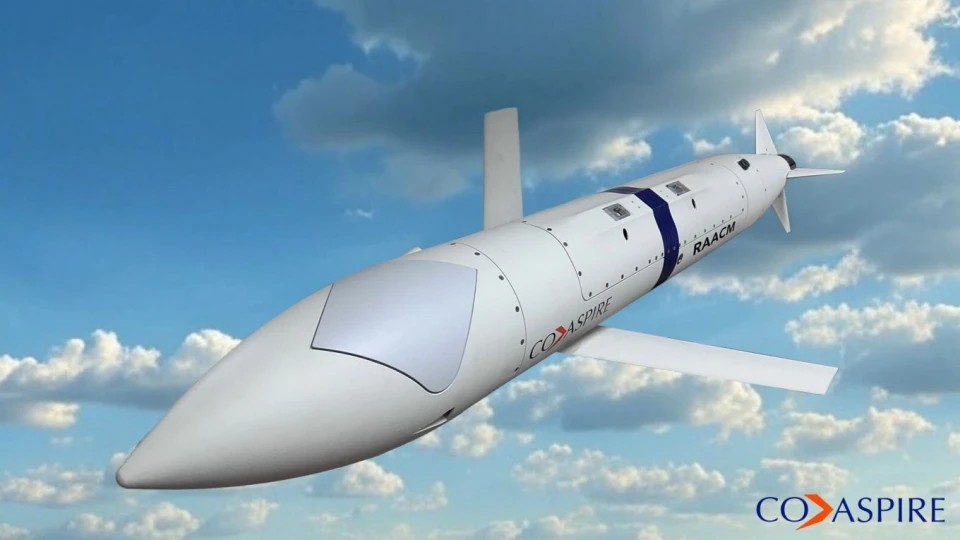“With a reach exceeding 400 km (250 miles), ERAM will allow Ukrainian pilots to engage high-value targets such as supply hubs, ammunition depots, airbases, and command centers without flying into the densest layers of Russian, surface-to-air missile systems like the S-400. This could force Russia to reposition logistics and command infrastructure deeper into its rear areas, stretching supply lines and complicating its ability to sustain frontline operations.” — Defense News Aerospace, August 24, 2025.
On August 28, 2025, the U.S. State Department officially announced the pending sale of 3,350 brand-new, Extended-Range Attack Munitions (ERAM missiles) to Ukraine, together with an equal quantity of embedded guidance and anti-jamming systems. The $850-million arms package will be mostly funded by NATO nations in Europe, specifically including Denmark, the Netherlands, and Norway.
The ERAM missile is designed to provide a low-cost, extended-range, precision munition to be launched from Ukraine’s F-16AM Fighting Falcon jet fighter aircraft, and the first delivery of these new weapons is expected in early October 2025.
ERAM is a 500-pound, air-launched, highly accurate, hybrid, standoff missile with a maximum range of 460 kilometers (286 miles), using combined GPS and inertial navigation to its target, with a high-explosive or blast-fragmentation warhead, capable of destroying fixed or mobile targets under heavy, electronic-warfare conditions, giving Ukraine a credible, deep-strike capability. It has an airspeed of Mach 0.6 (about 470 to 485 mph) and an accuracy level within 33 feet on the ground, even under intense, Russian electronic jamming efforts.

U.S. President Donald J. Trump delayed the decision to send ERAM missiles to Ukraine until after his very recent summit meetings in August with President Vladimir Putin of Russia and Ukrainian President Volodymyr Zelensky. ERAM’s simple and inexpensive design permits the production of more than 80 units per month, or approximately 1,000 weapons per year.
It’s a smaller, lighter, less-complex, less-expensive option than the $500k, U.S. AGM-154 Joint Standoff Weapon (JSOW), a 1,095-pound, GPS-guided, glide bomb with a range of 14 to 80 miles, already used by Ukraine since late 2024, or the AGM-158 Joint Air-to-Surface Standoff Missile (JASSM), a stealthy, 2,300-pound, turbojet-powered, cruise missile with an operational range of 230 miles.
The Pentagon’s initiative to produce smaller, lighter, lower-cost weapons is fairly new, aimed specifically at supplying Ukraine with highly effective missiles at a lower cost. The primary U.S. contractors to build these new weapons are Zone 5 Technologies of San Luis Obispo, California, and CoAspire of Fairfax, Virginia.
The U.S. Air Force Research Laboratory (AFRL) recently developed a compact, air-launched seeker module, called Quicksink, for precision targeting of enemy surface ships with aerial bombs, and the possibility exists that a modified version of Quicksink could be incorporated into ERAM missiles for naval strike missions.

Defense News Aerospace 2025 wrote on August 24, 2025, that, “ERAM represents one of the most consequential deliveries of the conflict…The combination of range, precision, and survivability makes ERAM more than just another missile; it is a tool that can disrupt Russia’s ability to concentrate forces and stage offensives while enabling Ukraine to regain initiative.”
There has been increasing pressure from NATO allies, particularly those who are either selling or donating their surplus F-16AM Fighting Falcons to Ukraine, for the U.S. to provide the embattled nation with more advanced weapons to counter the never-ending Russian invasion of Ukrainian territory. ERAM’s tactical range allows Ukrainian pilots to hit high-value targets anywhere within Russian-controlled areas of Ukraine.
Several officials have noted, however, that Ukraine will not have unrestricted, combat use of the new, advanced weapon system, which will apparently require case-by-case approval from the U.S. Department of Defense, in order to prevent any potential, escalatory strikes deep inside Russian territory using American weapons.

Mykhailo Samus, a Ukrainian journalist and military veteran, is the director of New Geopolitics Research Network, and he very recently wrote that, “The further course of history and the fate of the democratic world is being decided on the Russian-Ukrainian front. Summits and meetings serve more as a backdrop, often inadequate and detached from reality…These (ERAM) deliveries largely determine the resilience and capability of the Ukrainian Defense Forces to continue effectively countering Russian aggression.
“It is clear that allowing unrestricted strikes on Russian territory with U.S. weapons would be terrible news for the Kremlin, and a huge bonus for the Ukrainian Defense Forces…(However,) strikes on Russian territory could be carried out using Ukrainian long-range drones and missiles…massive, missile attacks from Ukraine could lead to a complete collapse of Russia’s petroleum product market. Therefore, paradoxically, the ban on using U.S. weapons against Russia could become a stimulus for even more active development and production of Ukrainian missile systems.”
Upcoming deliveries of new ERAM missiles to Ukraine, even with U.S. restrictions upon their use, will still enable Ukrainian pilots to strike targets virtually anywhere on Russian-controlled parts of their country, while keeping their distance from high-intensity, Russian air defense systems, so this is truly a significant development in the overall war effort.

